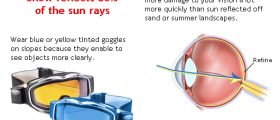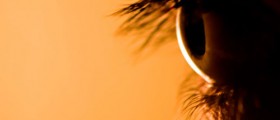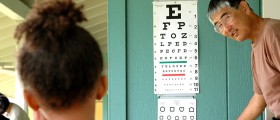
Refractive errors represent the most common group of eye conditions that affect the vision of people in the United States. These conditions develop as a result of an abnormal shape of the eye and its inadequate bending of light .
A normal and healthy eye bends and focuses light on the specific part of the retina. However, in people suffering from refractive errors the light focuses either in front of or behind the retina. There are two factors associated with refractive errors. The first one is the overall length of the eye and the second one is a change in curvature of the cornea. Some refractive errors such as myopia and hypermetropia are inherited.
Myopia
It is estimated that myopia (nearsightedness) affects more than 25% of all adult Americans. In case of this refractive error the cornea is curved too steeply, hence the eye is too long and the light does not fall directly onto the retina but is focused in front of the retina. Myopia commonly affects children between the age of 8 and 12. Their vision tends to deteriorate during teenage years and by the age of 20 the vision usually stabilizes.
Hypermetropia
Hypermetropia is found in babies and relatively young children. This condition may be overgrown and the normal eyesight can be restored spontaneously. This is the opposite condition to myopia. In hypermetropia (farsightedness) patients have problems when looking at the objects in the distance. The condition develops in case the eye is too short or if the cornea is too flat.
Astigmatism
Astigmatism is a refractive error characterized by an uneven curvature of the cornea. This leads to blurry vision and results in a distorted picture of both distant and near objects. In healthy people the cornea is round and has even curves from side to side and top to bottom. In people suffering from astigmatism some curves are more prominent. The abnormal curves are responsible for more than one focal point and focus on two separate areas of the retina.
Presbyopia
Presbyopia is a refractive error in older people (people over the age of 40). The condition develops as a consequence of loss of lens flexibility and weakening of the muscles attached to the lens. Presbyopia is characterized by blurred vision that occurs during 'close-up' tasks such as reading, sewing and working on a computer.
All of these refractive errors are treated differently but the appropriate sight can be successfully restored in a majority of cases with the assistance of glasses and contact lenses. And if these aids do not provide desirable results, the final option is surgical correction.

















Your thoughts on this
Loading...